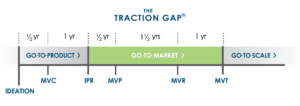Thinking Beyond the Product
February 19, 2019
PUBLISHED BY Wildcat Venture Partners
Okay, so you’ve declared Minimum Viable Product (MVP). You’ve nailed your value propositions and your pricing and terms, and you are confident that your category positioning is on point. Your team is now marketing and selling your product. This means your next challenge is to reach the Traction GapTM value inflection point called Minimum Viable Repeatability (MVR).

To reach MVR, you must demonstrate that you have been able to successfully release multiple versions of your product, market and sell your product many times to many companies, hire top talent personnel, and develop the internal systems that enable you to quickly and cost-effectively manage the business. This is the first significant step in your journey of “scaling” your business. And, to be on track with the best startups at this phase, you only have a year and a half to go from MVP to MVR.

Make no mistake: getting to this next Traction Gap value inflection point is the most difficult phase you and your team will face. As far as the venture investment community is concerned, your ability to go from MVP to MVR in the next 18 months — which, trust us, will fly by — will determine whether your startup sinks or swims. And during this time, not only will you need to demonstrate you can grow your business, but you may also be faced with having to raise your next round of capital. It’s one of those times when caffeine will be your savior.
This is an intense phase because you are now fully at the mercy of forces other than your own ingenuity. In the go-to-product phase, it was all you. Your design, your innovation, your decisions. But as you leave the go-to-product phase, you throw yourself upon the unforgiving market, in the form of potential consumers or customers. The market will either be convinced and purchase your product or service, or the market will toss your idea in the bin along with 80% or more of all other startups. Capitalism is ruthless.
So: the clock is ticking. After you declare Minimum Viable Product (MVP), savvy investors expect to see healthy growth metrics — downloads, conversion rates, usage rates, and revenues. If those metrics aren’t there, no amount of future promises will save you. A fancy slideshow or prototype describing how great it will eventually be will no longer cut it. You will be evaluated on hard, empirical metrics.
Here’s the crucial thing about getting to MVR. Remember how the Traction Gap Framework is built upon four core architectures of an enterprise: product; revenue; team; and systems? Up until now, most of your attention has been focused on developing and delivering the first version of a quality assured product using your product engineering and market engineering skills.
Now that focus shifts. Market awareness and demand are now crucial, and this means your requirements have shifted with it. At this phase, the other three Traction Gap pillars begin to play a more prominent role.
Here’s how these three pillars relate to the crucial MVP to MVR phase.
MVR & Team Architecture

The universal feedback from every CEO interview we have ever conducted is that team is by far the most important of the four Traction Gap architecture pillars. This is never more true than while the enterprise is working toward MVR. Most early-stage startup CEOs and their teams have experience building products — but once you’re moving beyond Minimum Viable Product (MVP), many teams begin to move out of their comfort zone.
At this point, you must begin the challenging process of expanding your team beyond people with specific product skills. You need to add a few team members with a mix of revenue and systems architecture skills. Furthermore, you must find people with a combination of strategy and execution skills — a rare breed. And, you can’t afford to hire the wrong people, because mis-hires at this stage cost time, a resource that is in short supply. This is a time when you can’t afford mistakes.
This is also the point in your company’s life cycle when a few members of your team — possibly even some of your closest friends, people who were with the company when it was just an idea on a napkin — may not be well-suited to continue. Some people can have great product talents, but not make great team members. Or, as the company grows, those with otherwise remarkable individual skills are not capable of scaling with the company. This is where the decision-making, instincts and the savvy of a good CEO are essential.
MVR & Revenue Architecture

Once you declare MVP, you are formally on the hook to start growing your customer or user base. And investors will expect you to grow at least as fast as comparable startups that use a similar business model. The race is on.
B2B
If you are a SaaS company, the following are the metrics that B2B companies such as Salesforce, Marketo, Workday, and many other now successful companies achieved when they were at this stage of growth:
- Once you reach MVP, you must grow your revenue to at least $1M (ending ARR) within one year.
- You must add another $1M ARR (a total of $2M ending ARR) in the following six months.
- So, from MVP you have twelve months to reach $1M ending ARR and another six months to reach at least $2M ending ARR, the minimum amount of ARR you will need to declare MVR.
An important comment about MVR here for B2B startups. Although revenue is certainly an important metric, so is the number of customers/users you’ve acquired. Investors want to see “repeatability” and that means obtaining a good number of logos (customers) or users who are deriving value from your product. So, if you have a complex enterprise application with an ACV of $500K, then four customers or less might generate $2M ARR. That isn’t MVR. Investors will likely want to see that you have at least 20 customers, maybe more, before feeling confident you have repeatability.
*A Note of Caution
Do not invest in significant marketing and sales resources until you reach at least $1M ARR. At this phase, the management team needs to act as the sales team and close the majority of new business. The reason for this is that you need to be extremely confident that you have a solid sales process (e.g., presentation, demo, service level agreements, etc.) and that your messaging (e.g., value propositions, category definition, et al) are really working before you bring on very expensive marketing and sales resources. Many startups burn through a lot of capital only to realize after it’s too late that they haven’t nailed the market engineering. Don’t do it.
B2C
If you are a B2C software startup, you differ slightly from your B2B brethren, in that reaching MVR is not typically linked to revenue. Instead, investors will judge your success on other factors such as downloads, daily active usage rates, and churn.
After interviewing many successful B2C investors, we were surprised to learn that most don’t use hard and fast metrics to determine MVR — the earliest point in time where good venture investors are willing to make a serious investment in a B2C software startup. That said, a common MVR metric we’ve heard cited by a number of venture firms skilled in B2C investments seems to converge around 1M active users.
Since most B2C software startups use a revenue model supported by advertising or data monetization, the size of the overall user base and the frequency at which the application or marketplace is accessed determine its ultimate value. So, it makes sense that investors look for similar metrics that advertisers will value.
MVR & Systems Architecture

When you are initially advancing from MVP to MVR, you do not need many more systems beyond the ones you set up at the beginning of your startup. And, most of those should be primarily back office-oriented for the finance (e.g., payroll, A/P, A/R, etc.), engineering, and product teams.
However, as you move further away from MVP and closer to MVR, you will need to investigate specific front-office marketing and sales technologies that you will want to use to power your business model and successfully scale.
At this point, the typical challenge becomes selecting from the more than 7,000 marketing and sales technologies available in the marketplace. It can be an overwhelming, paralyzing experience.
We suggest keeping the process as simple as possible and using industry-leading software, for no other reason than when you hire marketing and sales personnel, they are likely to know how to set up, run, and maintain your selected applications.
You Can Do It!
Getting from MVP to MVR will be your toughest entrepreneurial challenge. But it’s doable. It’s a transition phase; when you make it, you will have transitioned from being a slide deck startup to a spreadsheet startup — a company with real performance you can show an investor. It’s all about metrics now: month-over-month growth, churn, downloads, and all the rest. The Traction Gap Framework can help guide you by expanding your thinking beyond a narrow focus on product to a broader view that includes the other core architectures: revenue; team; and systems. With this wider lens, you can continue your journey in confidence toward traction and steady growth.This article is the sixth in a series of blog posts related to the Traction Gap, the challenging go-to-market phase where the vast majority of early stage startups — more than 80% — fail.
……….
This article is the seventh in a series of blog posts related to the Traction GapTM, the challenging go-to-market phase where the vast majority of early stage startups — more than 80% — fail.
To read the prior blog posts about the Traction Gap, click here.
To get a copy of the book, “Traversing the Traction Gap”, click here.
To get a deeper understanding of the Traction Gap principles, check out these resources:
KEYWORDS